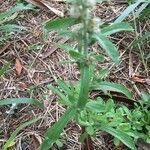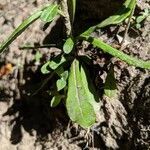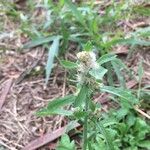Annuals, 10–50 cm; taprooted. Stems erect to decumbent or procumbent, loosely arachnose-tomentose. Leaves basal and cauline, proximal usually present at flowering, blades spatulate to oblanceolate-obovate, 2–7 cm × 4–16 mm (becoming spatulate to oblanceolate bracts among proximal heads, surpassing glomerules, bases narrowed to petiolar regions, margins sinuate, apices often apiculate), faces concolor or weakly bicolor, loosely tomentose. Heads in glomerules in continuous or interrupted, spiciform arrays 1–12 cm × 10–15 mm (pressed). Involucres cupulate-campanulate, 3–3.5 mm, bases sparsely arachnose. Phyllaries in 3–4 series, outer ovate-triangular, lengths 1/2–2/3 inner, apices attenuate-apiculate, inner oblong, laminae often purple-tinged (at stereome), apices (transparent, sometimes golden) acute to obtuse. Florets: bisexual 3–4; all (or at least bisexual) corollas usually purplish distally. Cypselae (tan) 0.4–0.5 mm. 2n = 28.
Annual herb, up to 400 mm high. Leaves alternate; blade obovate, narrowed to petiole-like base, apex rounded, margins entire, decreasing in size upwards, upper leaves flat, not folded or recurved; loosely white-woolly on upper surface, densely so on lower surface, not discolorous. Heads disciform, sessile, in small, axillary glomerules, racemosely arranged. Involucral bracts 3-seriate, buff-coloured or pale brown, apices pellucid, stereome undivided. Flowers: outer female florets many, filiform; disc florets 2 or 3, whitish, tipped red-purple; Apr.-Nov. Fruit with cypsela oblong, minutely myxogenic hairy, duplex hairs globose. Pappus of many scabrid bristles, bases fused in smooth ring.
Soft herb, branched from the base, probably annual, all parts loosely white-woolly, stems to about 400 mm, often the central one erect, the laterals decumbent then erect, rooting where they touch the ground. Leaves up to c. 80 x 20 mm, narrowly spathulate, decreasing in size upwards and passing into inflorescence bracts. Heads c. 3 x 2 mm, in small axillary glomerules racemosely arranged. Involucral bracts in c. 3 series, innermost about equalling the flowers, pellucid, palest brown or buff. Flowers c. 80-100 ('female'), 2-3 ('bisexual'), whitish, tipped red-purple. Achenes 0.5 mm long, minutely hairy, myxogenic. Pappus bristles many, scabrid, bases fused in a smooth ring.
White-woolly, annual herb, up to 400 mm high. Leaves alternate, spathulate, decreasing in size upwards, entire, not discolorous. Capitula disciform, in small axillary glomerules racemosely arranged; involucral bracts in ± 3 rows, pale brown or buff-coloured. Female florets filiform, outnumbering disc florets, whitish, tipped reddish purple. Disc florets bisexual, whitish, tipped reddish purple. Flowering time (May) Sept.-Nov. Pappus of many barbellate bristles in 1 row, bases fused in a smooth ring. Cypselae small, oblong, minutely hairy.
Herb, up to 400 mm tall. Leaves spathulate, not discolorous. Heads in small axillary glomerules racemosely arranged. Flowers whitish, tipped red purple.



